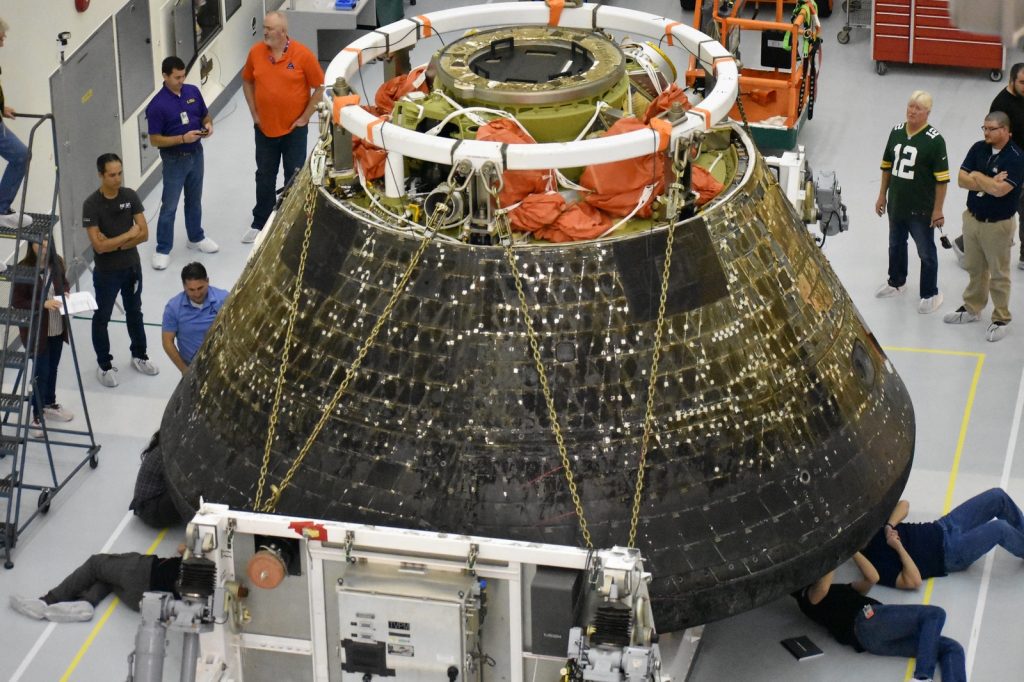WASHINGTON — A report by NASA’s inspector general has revealed new information about challenges with the Orion spacecraft’s heat shield and other problems that caused a delay in its first crewed launch.
The May 1 report by the NASA Office of Inspector General (OIG) looked at issues with the Orion spacecraft, as well as ground equipment and the Deep Space Network, from the uncrewed Artemis 1 mission launched in late 2022.
One of the major issues was with the Orion heat shield. NASA revealed that more of the ablative heat shield material had been lost during reentry than anticipated, but assured that it has not endangered the safety of the spacecraft. NASA is still investigating what happened to the heat shield, and that was one of three problems that prompted the agency in January to postpone the Artemis 2 mission from late 2024 to no earlier than September 2025.
According to the OIG report, NASA discovered over 100 spots on the heat shield where material “chipped away unexpectedly” during the Artemis 1 reentry. The report included pictures displaying pockmarked sections of the heat shield that had not been previously released by the agency.

The heat shield material, known as Avcoat, “wore away differently than NASA engineers predicted, cracking and breaking off the spacecraft in fragments that created a trail of debris rather than melting away as designed,” the report stated. “The unexpected behavior of the Avcoat creates a risk that the heat shield may not sufficiently protect the capsule’s systems and crew from the extreme heat of reentry on future missions.”
NASA has yet to find a root cause for the behavior of the heat shield material. In a response accompanying the report, Cathy Koerner, NASA associate administrator of exploration systems development, stated that ground testing “successfully recreated char loss” and that that the material in those tests “has the same features as observed on the Artemis I heat shield.” But the OIG report noted that while NASA was able to recreate the char loss, “they could not reproduce the exact material response or flight environment experienced during Artemis I.”
At an April 26 meeting of the NASA Advisory Council’s human exploration and operations committee, Amit Kshatriya, deputy associate administrator for the Moon to Mars Program, said understanding the heat shield performance was the top risk for the Artemis 2 mission.
The focus, he said, is understanding the “fundamental physics” of the heat shield material and how it could come loose during reentry. “We’re getting close to the final answer in terms of that cause,” he said, while others analyze potential changes in the reentry trajectory to alter the heat load on the capsule.
“When we stitch it all together, we either will have flight rationale or we won’t,” he concluded. He didn’t estimate when that would be done, although NASA’s response to the OIG report offered a planned completion date of June 30.
The OIG report mentioned that three of four separation bolts on the base of the heat shield had unexpected melting and erosion due to a thermal model discrepancy, in addition to the heat shield char loss.
For future Orion spacecraft, NASA plans to redesign the separation bolt and install extra thermal protection material for Artemis 2. However, the work for Artemis 2 depends on NASA's completion of the overall heat shield.
The report also mentioned issues with a power distribution unit on the service module and a problem with a Deep Space Network station in California causing a 4.5-hour loss of communications with Orion during the Artemis 1 mission.
The report highlighted documented damage to the mobile launch tower, including damage to the elevators due to inaccurately modeled low-frequency acoustics and the use of fiberglass doors instead of blast doors. The repairs to the mobile launcher cost $26 million, exceeding NASA's $5 million budget.
The report provided six recommendations for addressing the issues found during the Artemis 1 mission, which NASA accepted. However, NASA complained that the OIG audit disrupted ongoing workflow and priorities and focused more on engineering than understanding risk management.
OIG defended its approach to reviewing the Artemis 1 mission, stating that providing timely recommendations for ensuring astronaut safety in the upcoming Artemis II mission is a crucial responsibility of their office. They emphasized their commitment to overseeing the Artemis campaign appropriately.









